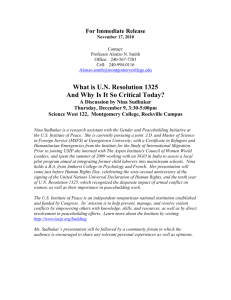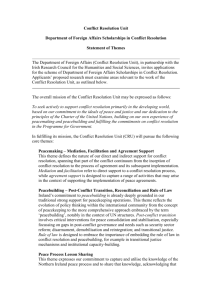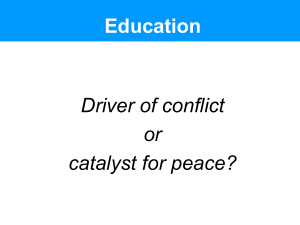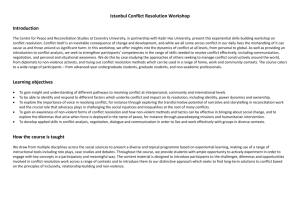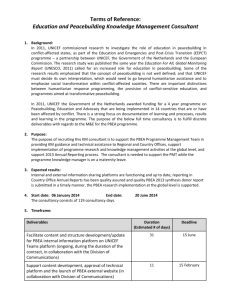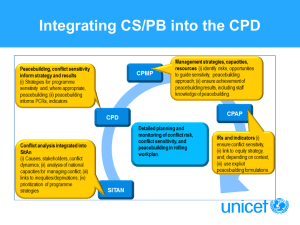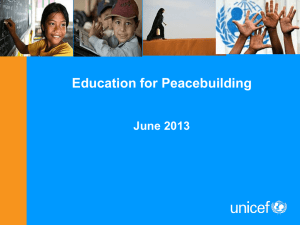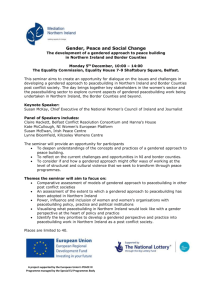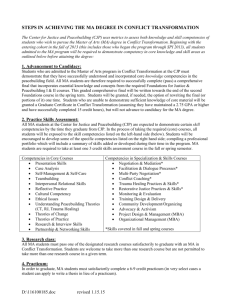long-term peacebuilding: where are the women
advertisement
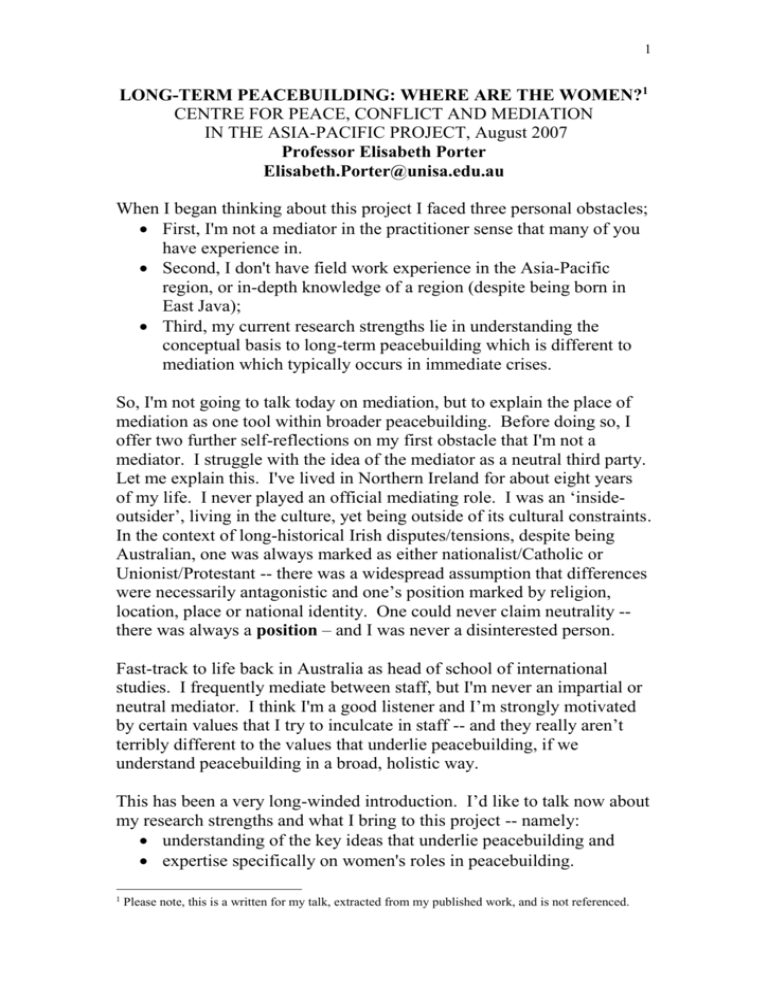
1 LONG-TERM PEACEBUILDING: WHERE ARE THE WOMEN?1 CENTRE FOR PEACE, CONFLICT AND MEDIATION IN THE ASIA-PACIFIC PROJECT, August 2007 Professor Elisabeth Porter Elisabeth.Porter@unisa.edu.au When I began thinking about this project I faced three personal obstacles; First, I'm not a mediator in the practitioner sense that many of you have experience in. Second, I don't have field work experience in the Asia-Pacific region, or in-depth knowledge of a region (despite being born in East Java); Third, my current research strengths lie in understanding the conceptual basis to long-term peacebuilding which is different to mediation which typically occurs in immediate crises. So, I'm not going to talk today on mediation, but to explain the place of mediation as one tool within broader peacebuilding. Before doing so, I offer two further self-reflections on my first obstacle that I'm not a mediator. I struggle with the idea of the mediator as a neutral third party. Let me explain this. I've lived in Northern Ireland for about eight years of my life. I never played an official mediating role. I was an ‘insideoutsider’, living in the culture, yet being outside of its cultural constraints. In the context of long-historical Irish disputes/tensions, despite being Australian, one was always marked as either nationalist/Catholic or Unionist/Protestant -- there was a widespread assumption that differences were necessarily antagonistic and one’s position marked by religion, location, place or national identity. One could never claim neutrality -there was always a position – and I was never a disinterested person. Fast-track to life back in Australia as head of school of international studies. I frequently mediate between staff, but I'm never an impartial or neutral mediator. I think I'm a good listener and I’m strongly motivated by certain values that I try to inculcate in staff -- and they really aren’t terribly different to the values that underlie peacebuilding, if we understand peacebuilding in a broad, holistic way. This has been a very long-winded introduction. I’d like to talk now about my research strengths and what I bring to this project -- namely: understanding of the key ideas that underlie peacebuilding and expertise specifically on women's roles in peacebuilding. 1 Please note, this is a written for my talk, extracted from my published work, and is not referenced. 2 If we take mediation to be a non-coercive, voluntary form of conflict management aimed at helping those involved in a conflict to achieve a better outcome than possible by the parties alone, I suggest to you that women in all cultures typically practice daily mediation in dealing with squabbling children, angry neighbours and between aggressive men. In these instances, women rarely are neutral -- -- they are interested parties. Let me clarify from the start, women aren't natural peacemakers -- many are aggressive combatants or guerrilla fighters particularly in Algeria, Eritrea, Ethiopia, Liberia, Mozambique, Nicaragua, Namibia, Sierra Leone, Sri Lanka, South Africa and Zimbabwe. However, because women are the primary nurturers in families and communities, they have a large stake in community stability. Women's contributions usually aren't part of formal peace processes. My question today is where are the women? The answer is very straightforward. They’re active in: track II diplomacy with unofficial actors working informally as a citizen diplomacy and in track III diplomacy with unofficial interventions at the grassroots. What do I mean by long-term peacebuilding? In the United Nations, peacebuilding typically refers to formal postconflict reconstruction. Yet even the idea of ‘post-conflict’ is problematic. It usually refers to that period when predominantly male combatants have ceased to engage in official war but insecurity continues. While the guns are silent, the machetes or spears temporarily laid aside, cultural, domestic and structural violence remains. The idea of ‘reconstruction’ also has to be interrogated. It presupposes a restoration of conditions that may never have existed, particularly for women who’ve been excluded from rights and freedoms. It's important to keep the distinction between the immediate demands of peacebuilding after violence has ceased and peace settlements are being negotiated and signed, and longer-term peacebuilding undertaken by local NGOs across civil society in political, economic, humanitarian, legal and social spheres. Mediation can be part of dealing with immediate crises and part of this longer-term peacebuilding. 3 In terms of long-term processes, grassroots women's groups emphasise the centrality of addressing psychosocial and human needs in their peacebuilding work far more than do governmental organisations, NGOs or United Nations. In my forthcoming book, Peacebuilding: Women in International Perspectives to be released by Routledge in September this year, I defined peacebuilding in broad holistic terms: Peacebuilding involves all processes that build positive relationships, heal wounds, reconcile antagonistic differences, restore esteem, respect rights, meet basic needs, enhance equality, instil feelings of security, and power moral agency and are democratic, inclusive and just. This demanding definition of peacebuilding is directed toward tackling the root causes of insecurity -- -- including the violation of human rights, gender-based violence, all forms of inequality and injustice, poverty, disease, organised crime, sexual trafficking, political corruption, environmental degradation and terrorism. It’s an expansive notion of peace linked to security and justice. Peace and security have to be grounded in the immediacy of fulfilling ordinary daily needs, which is why conditions that free people from poverty, exclusion, injustice and oppression enhance security. It is in this practical arena of fulfilling immediate practical needs that we find women. The UN Security Council resolution 1325 on ‘Women, Peace and Security’ (2000) is historical in being the first Security Council resolution to address the special needs of women in relation to peace and security. It’s unprecedented in acknowledging the importance of involving women in all peacebuilding measures and calling for increased representation of women at all levels of decision-making to prevent, manage and resolve conflict. And here I have to say -- -- I need to do much more work for this project in understanding women's contributions in the Asia-Pacific region. I’ve been working in Northern Ireland and have a broad, global understanding, but I need to increase my knowledge of our own region. Let me build a case for why it's important for women to be involved in official peace processes. While women are at the forefront of peace initiatives, peace agreements are usually negotiated predominantly, often exclusively by men whether we're talking about Burundi, Guatemala, Liberia, Northern Ireland, Sierra Leone or Tajikistan. 4 It matters if women aren't included in all stages of peace processes for three reasons. First, women are affected by conflict and thus by the consequence of the peace agreement. It's not just about ending the conflict, but about establishing revised terms for a new, just polity. Injustice isn't just a consequence of conflict, but a symptom and cause. While entire communities suffer after violence, women have to continue to care for dependants, including traumatised children, many are left as heads of households with destroyed huts and inadequate food. Exclusion exacerbates gendered subordination and overlooks women's capacity to broker agreements in their neighbourhoods and mediate petty squabbles and forge workable, practical solutions to everyday dilemmas. Second, women's inclusion is necessary to further social Justice. Peace that is supported at grassroots is more likely to be sustained than one negotiated among elites. Third, where they are present, women bring an understanding of the root causes of conflict and focus on practical issues like education, health, nutrition, childcare, credit and land and human welfare concerns. The importance of listening to local women who’ve lived through conflict is crucial. They often ask for the unexpected. For example, in Bougainville, it was important for women that communication and transport services were restored and that church group should participate in the rehabilitation programs. At the Afghan women's summit of democracy in 2001 that ran parallel to the Bonn Agreement, women urged provisions on education, health, human rights and the Constitution. For women in Burundi, equality issues were access to education, legislation of women's rights to inherit land and prosecution of crimes of sexual violence. If we look at the global view of women, representation, peace and security, increasing the representation of women is fundamental to Security Council Resolution 1325. The first stage in overcoming gender inequality is to enshrine the principle of equality in constitutional, electoral, legislative and judicial reforms. In South Africa, Cambodia and East Timor, women's groups organised to develop women's charters to do so. 5 When we look at the numbers of women in Parliament we find some curious 2005 statistics. There are no women in Parliament in Bahrain, Kuwait, Micronesia, Nauru, Palau, St Kitts and Nevis, Saudi Arabia, Solomon Islands, Tonga, Tuvalu, United Arab Emirates and GuineaBissau. Where do you think there's the highest representation of women? Rwanda 48.8% Sweden 45.3%, then in order Denmark, Finland, Netherlands, Norway, Cuba, Spain, Costa Rica, Belgium, Austria, Argentina, Germany, South Africa and Iceland If we concentrate on conflict situations, 2006 figures show countries with more than 30% include Rwanda, 48.8%, Mozambique 34.8%, South Africa 32.8%, Burundi 30.5% with Namibia, Timor-Leste, Uganda and Eritrea all having more than 22% of women representatives. Why have I gone into this much detail on representation in the context of today's seminars and this project? My reason is straightforward -- -- none of the statistics are accidental. The high representative levels have occurred in the process of democratisation with extensive practical support from the international community, particularly UNIFEM including: training in decision-making and political awareness practical workshops developing capacity-building to foster local leadership cultural adaptations of brochures on 1325 women's councils in grassroots levels assistance in writing gender-inclusive constitutions that include reserve seats (in Rwanda) or quotas (in Mozambique and South Africa). Much of this project is concerned with cultural differences and understandably, a deep desire not to impose Western, inappropriate traditions. But, the international community plays a crucial role in affirming universal rights to equality, justice and human rights and can work productively with local leaders to facilitate the particular meanings of equality, justice and rights to emerge in ways that make sense to local people. 6 I believe that it is possible to build recognition of difference into mediation and peacebuilding – recognition of cultural difference, local difference, gender difference as well as individual needs into the protection of principles of justice. Justice recognizes and considers relevant differences, it views equal treatment as inherently responsive to specific injustices and defined by difference, including differentiated responses to peoples’ needs. In our own region, instability remains in Bougainville, East Timor, Fiji, Indonesia, PNG, West Papua and the Solomon Islands. Some ADF personnel are being trained to promote Resolution 1325 through an annual International Peace Operations seminar. In 2007, the Australian government supported a Pacific Islands Forum Regional Workshop on ‘Gender Conflict Peace and Security’. I’d like to conclude by reiterating that the achievement of sustainable peace is more likely when gender equality and women's rights issues are made a central aspect of reconstruction. Peacebuilding is contextual, grounded and shaped by the particular conflict and thus relies on local strategies. I look forward to doing more research on the strategies women typically use in the Asia-Pacific region.
